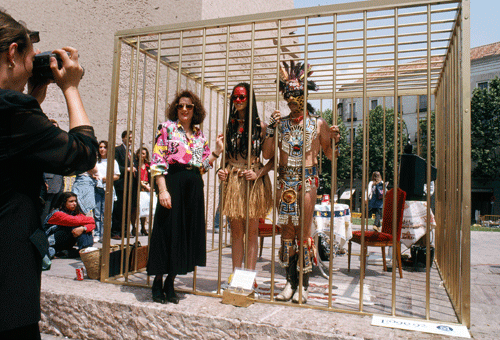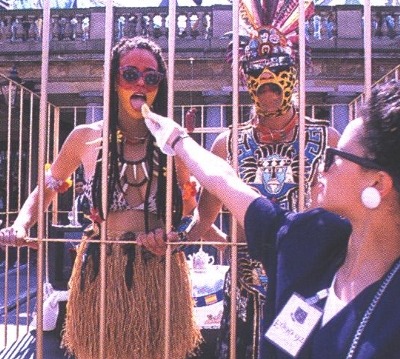Title: Two Undiscovered Amerindians
Year: 1992
Coco Fusco is an interdisciplinary artist who,
alongside her partner Guillermo Gunez-Pena created a performance piece called, Two Undiscovered Amerindians. The role
of the artist’s body was to become what appeared as caged Amerindian from an
imaginary island. Alongside her partner Guillermo Gunez-Pena, they dressed in
leopard skin as well as Aztec-styled attire to appear as if they were linked to
some native tribe. They traveled across Europe and America to explore and
research the various reactions from the public. The title of the piece was
design to interact with the audience so that, “once the audience became
involved, the performance was supposed to reveal the critique at its heart,”
(Byrd, 19). They found that in America, majority of the reactions were
emotional and upsetting, as opposed to Europe who took it as a comical joke. In
fact Fusco recalls that, “…their worst experiences with racism occurred in the
very places where the history of the display legacy should have had the
strongest resonance,” (Quinlivan, 96). Their study to watch their reaction soon
turned on them as people actually thought they were native indigenous people.
Their performance, “…became a reverse ethnography—or the mission of their
observational performance was overturned—because Fusco and Gomez-Peña
discovered that several audience members actually believed they were ‘real’
undiscovered Amerindians,” (Quinlivan, 95).
Coco Fusco
and Gunez-Pena were surrounded by a ten-by-twelve-foot cage and located
themselves in various malls and museums around the world. This allowed their
performance to be heavily spectated by the public, welcoming a plethora of
reactions to this social experiment. They were documented through a video
camera and created a film titles, “Couple in the Cage”, which combined, “…archival footage of ethnographic displays
from the past, giving an historical dimension to the artists’ social
experiment,” (www.thing.net). The film
helped engage the viewers and further portray the moralities of exhibiting
human beings as well as its cultures.
Resources:
Byrd, J. A. (2002).
Colonialism's cacophony: Natives and arrivants at the limits of postcolonial
theory. The University of Iowa). ProQuest Dissertations and Theses, , 230-230
p. Retrieved from http://search.proquest.com/docview/305515015?accountid=14667.
(305515015).
Quinlivan, R. L. (2008). Corporeality and the rhetoric of
feminist body art. The Pennsylvania State University). ProQuest Dissertations
and Theses, , 177-n/a. Retrieved from
http://search.proquest.com/docview/304506766?accountid=14667. (304506766).
http://www.thing.net/~cocofusco/subpages/videos/subpages/couple/couple.html


No comments:
Post a Comment